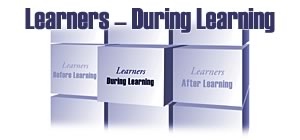Participate actively in the course
The more actively you participate in course sessions, exercises
and other interactions with trainers and fellow learners, the more knowledge
you will acquire. Active participation allows you to draw from the experiences
of others, clarify content, practice skills and explore how you will apply
the new skills in your job. Active participation includes:
-
being on time for and actively engaged in
all learning sessions including discussions, problem-solving exercises,
team projects and skill practice sessions
-
asking questions about the course content
as it relates to your specific job
-
trying out new behaviors where appropriate
during the course and requesting feedback to improve your skills
-
sharing your ideas and requesting feedback
from trainers and other learners
-
discussing challenges and questions individually with trainers when
possible (e.g., after class, during breaks, in between sessions, during
site visits).
Additional mechanisms that can promote your active
involvement in the course include:
-
Identifying one or more learners (buddies) with whom you can complete
assignments, share ideas and discuss what you are learning.
It's helpful to exchange ideas about how new skills can best be used in
your job and to practice the skills that are applicable. A "buddy"
relationship is most effective between co-workers or others with whom you
can make a commitment to have an ongoing connection that will permit you
to support each other after the training event. Linking with a learning
buddy who is your co-worker allows you to identify important performance
goals as a team and create a joint action plan for application at your work
site, including details on how your plan will be shared with your supervisor
and other co-workers. Other post-training support may come from professional
associations and formal peer associations.
-
Writing reflections about what you are learning.
Making notes in a learning journal can help you retain knowledge and
skills, share the most relevant information from training with your supervisor,
and focus on the best ways to implement new practices at work. Your trainer
may give you opportunities to write in your learning journal during the
training sessions. In your journal, you can also keep track of problems
and questions that you want to pursue with the trainer or other learners
and make notes about the support and resources you think you will need
to put new skills into practice. If you add to your journal throughout
the training program, you can use it as a reference when you complete
and implement your action plan.
Develop realistic action plans for transferring learning
The preliminary action plan developed with your supervisor — or
the discussions that you and your supervisor had regarding expectations for
the training—provide the foundation for your action plan. If your preliminary
action plan was not a formal document, ask your trainer to provide you with
guidelines and a format for developing a written action plan or
refer to the sample plan. Refer to your learning journal
and use what you have learned from your participation in the course as a basis
for refining your action plan. Most action plans incorporate areas for improvement
(describing measurable and achievable goals and objectives), anticipated problems
or barriers you will overcome, and specific actions to be taken. For each
action, identify the person responsible, any resources needed, a target date
for completion and changes you expect to occur as a result of the action.
Some of the actions may highlight additional skills practice or self-development
activities to help you reach your goal.
As you prepare to implement your action plan, consider using the following techniques:
-
If feasible, make plans to have a trainer visit your work site or be available
to consult with you and your supervisor after training to help facilitate
implementation of your action plan.
-
Try to anticipate potential areas of resistance
(e.g., from supervisors, co-workers or administrative staff) or barriers
at your work site (e.g., logistical or supply and equipment problems).
-
With your trainer or a learning buddy, brainstorm
about how these barriers can be overcome and determine what resources and
types of support are needed to surmount the obstacles.
-
Include the steps identified for overcoming barriers in
your action plan.
|
